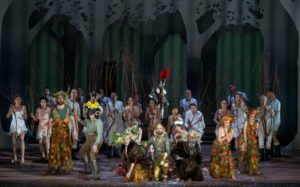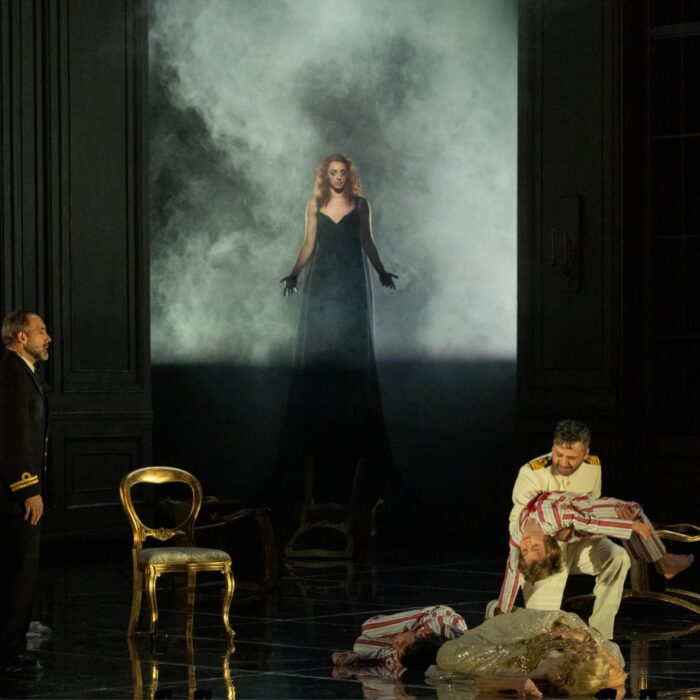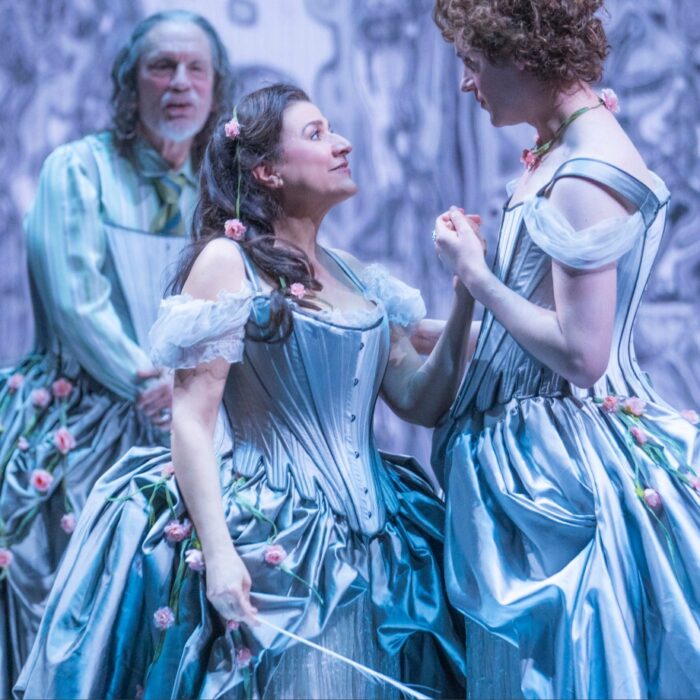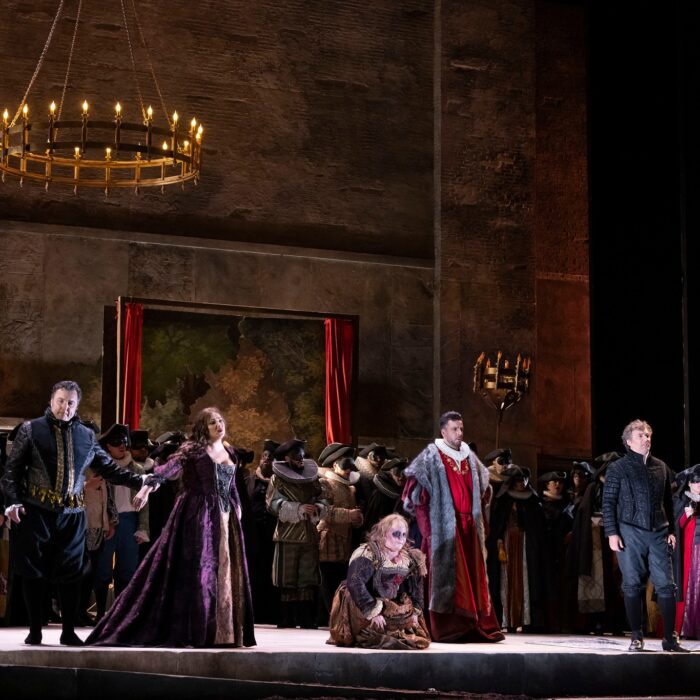
Staatsoper Berlin 2019-20 Review: King Arthur
A Confusing Production Starring Anett Fritsch That Explores Purcell’s Unbelievable Originality
By Elyse LyonThe Staatsoper Berlin’s “King Arthur,” in its current production by Sven-Eric Bechtolf and Julian Crouch, began with a deceptively childlike staging.
Thirteen empty chairs lined the edge of the stage, their backs against a scrim with the pale blue and white pattern of wallpaper. As René Jacobs led the Akademie für Alte Musik Berlin through the overture, actors entered from the wings until only a single chair remained empty. All were elegantly dressed, in suits and gowns and one vast mink coat. Several bore presents. Servants hovered in the wings, attired in the crisp black-and-white uniforms of an upper-class British household of the first half of the 20th century. The occasion, as it quickly emerged, was the birthday party of a young child: disobedient young Arthur, who at first failed to respond to his mother’s call and then pelted across the stage with a paper airplane, chased by a flustered servant.
“King Arthur” is a semi-opera, its narrative conveyed more through spoken dialogue than through music, and the directors have taken the opportunity to refashion the work as an episodic story-within-a-story.
John Dryden’s spoken text had not only been translated into modernized German, but also set within a framing device: young Arthur’s father, a British pilot, had recently died in the war. Young Arthur was evidently struggling to cope with his father’s death, hence his disobedience toward his mother. His birthday gift from his grandfather was a book containing the tales of King Arthur and Merlin and their battle against the Saxon King Oswald; his remaining gifts were puppets portraying figures from these legends. As the puppets emerged from their boxes and young Arthur’s grandfather began to read from his book, the birthday party melted away into the scenes of which the grandfather was reading.
This was, on several levels, a confusing framing device. Most perplexing was its appearance of simplicity and straightforward humor. Much of the production was reminiscent of theatrical productions aimed at children: the exaggeratedly comedic performances of the actors; the framing device, with its eight-year-old hero and his storytelling grandfather; its depiction of wizardry, with sound effects and flashes of light straight out of a children’s cartoon; the colorful, visually enticing set, in which bedrooms transformed into enchanted forests and spirits walked through walls.
One felt, at times, as if one had strayed into the wrong performance: not an erudite Staatsoper production, but something intended for school groups.
A framing device so deeply reminiscent of children’s theater led its audience to expect a simple and easy-to-follow story. Instead, the narrative was difficult to follow even after a repeat viewing. The characters at young Arthur’s party metamorphosed into the characters from Arthurian legend, and then back again, without clear boundaries between legend and reality. Sometimes young Arthur’s mother was the blind princess Emmeline; sometimes she was simply young Arthur’s mother. King Arthur, meanwhile, was often synonymous with Arthur’s dead father.
Perhaps a child, viewing the production, would not have struggled to make sense of the plot, but would simply have been enchanted by the beauty and magic of the production—but there were no children visible in the audience.
As the performance progressed, too, its themes became explicitly adult. The sorcerer Osmond, portrayed by the actor Paul Herwig, spent much of Act three with a foot-long erection, attempting to rape Meike Droste’s Emmeline either by sorcery or force. This scene, bizarrely enough, was played entirely for laughs, with no apparent concern for the fact that rape is not funny. Later, in the enchanted wood, Michael Rotschopf’s King Arthur did not (as per Purcell and Dryden) resist the temptation of the nymphs and sirens, but succumbed and engaged in an orgy.
Comedy or Fever-Dream?
At an initial viewing, the production appeared to take Monty Python as a primary inspiration: the Saxon King Oswald rode a hobby horse to his battle with King Arthur, where Princess Emmeline appeared on roller skates; Osmond addressed the audience in a comedic monologue about the “damn Middle Ages,” with its millet gruel and filth and its dearth of Porsches and yachts. During the fifth act, “For Folded Flocks, on Fruitful Plains” was inserted as a commercial for British Wool sung by finger-snapping butlers (“We do hope you’re enjoying this evening’s performance!”).
On a second viewing, however, the production seemed to be propelled less by comedy than by a serious-minded exploration of young Arthur’s psychology.
The legendary stories played out on stage reflected young Arthur’s inner turmoil: his grief for his father, his denial that his father was actually dead, and his resentment of his mother’s affair with a man who was not his father. At times, the treatment of young Arthur’s character evoked the psychological tumult of Shakespeare’s Hamlet. Just as Hamlet is haunted by the ghost of his father, young Arthur was visited by the blood-spattered ghost of his father. Where Hamlet sinks into madness, young Arthur lay in bed with a fever and dreamed strange fever-dreams in which his parents reunited, or in which his mother was hounded by lascivious creeps and his father enticed into orgies.
The same actor who portrayed the Saxon enemy King Oswald was also young Arthur’s mother’s new lover, and the production culminated with their marriage. Unlike Hamlet, however, young Arthur’s inner turmoil was portrayed as something that must be healed and transcended. Oswald was no enemy of young Arthur’s father, but rather a gentle, peace-loving man who evidently strove to become a good stepfather.
It remained difficult, nevertheless, to fully grasp the driving idea behind the production. On one hand, it seemed intended as comedy—but the comedy was only intermittently funny. On the other hand, it seemed to portray the feverish imaginings of young Arthur’s tormented mind—but those imaginings did not always seem to mesh with the Monty Python-style comedy.
Even so, the production was ultimately memorable for its inventiveness and sheer magic. While the spoken scenes sometimes dragged, unrelieved by the propulsive pleasures of Purcell’s music, the staging consisted of one bewitching scene after another. Notable was the production’s tasteful and effective use of projections.
The scene of King Arthur’s temptation in the enchanted wood was one especially winsome example, combining the modern technology of projections with an endearingly antiquated use of painted “waves” moved by stagehands to create an onstage river.
A Musical Delight
Due to the preponderance of extended spoken scenes, the production made use of a variety of additional music. Some of this music was sung onstage: “Happy Birthday” at young Arthur’s birthday party, German-language folk songs in other parts of the production. Often, the orchestra played soft background music while the actors spoke.
At first, this background music was frustrating. At times, it was difficult to hear either the orchestra or the actors very clearly. As the evening progressed, however, and one’s ear became accustomed to the use of background music, it served its purpose admirably. In Act three, in particular, the orchestra conjured up eerie veils of sound that wonderfully amplified the atmosphere of enchantment onstage.
The orchestra, throughout, was distinguished by tastefulness, zest, and responsiveness to the drama onstage. When young Arthur, in the opening scene, cast his paper airplane down, the orchestra imbued the music with a snap of anger that made the child’s frustration clear. In the Frost Scene, the strings snapped and shivered with evocative briskness, then melted into warmth with “’Tis I That Have Warm’d Ye.” The score glowed with life and energy, wonderfully conveying the pleasure and originality of Purcell’s music. One only wished to hear more music and less talking—but that, of course, is the fault of the work’s genre, not the performance.
Among the singers, Anett Fritsch (her roles described on the cast list as “Philidel, A Shepherdess, Cupido, A Siren, A Nymph, Venus”) particularly excelled, both vocally and dramatically. It was thrilling to hear her transform from one character into another.
As Philidel, she embodied the character of the “Airy Spirit” both in her spoken and sung portrayals. Her voice was light and lithe, creamy and dreamy, and she imbued the character with a playful coyness and magnetism that made Philidel’s personality obvious through the sheer effect of Fritsch’s singing.
As Cupido, she was brash and confident, Philidel’s lithe sweetness stripped away and supplanted by boyish cockiness. As Venus, she sang with a glossy, womanly sound that made the character of the goddess of love leap into being: a little flamboyant, a little slickly artificial, like a Photoshopped magazine beauty. Her English diction was excellent throughout.
Her fellow soprano, Robin Johannsen (“A Priest, Honour, A Shepherdess, She, A Siren, A Nymph”) was another standout singer, her sweet, clear voice delightful to listen to and dramatically effective, and her diction convincingly British (though the singer herself is American).
Neal Davies satisfied as “A Priest, Grimbald, The Cold Genius, A Sylvan, Aeolus, Peasant, Comus,” his strong bass impressively portraying the Cold Genius in tones of frozen anguish touched with appropriately brief moments of waking warmth.
Much of the music is written as choruses, and the Staatsopernchor excelled throughout. Particularly delightful was “Your hay it is Mow’d, and your Corn is Reap’d,” in which they portrayed the drunken peasants with a well-rehearsed precision that superbly conveyed joy, intoxication, and coarseness.
A Convincing Argument for Purcell
This production of “King Arthur,” originally premiered in 2017, was revived this season as part of the Staatsoper’s second Baroque festival, which focused, this year, on Scarlatti and Purcell. Along with “King Arthur” and “Dido and Aeneas,” the festival presented a range of Purcell’s other work, from “Fairy-Queen” excerpts to the more serious-minded pleasures of the Fantasias and In Nomines.
Most intriguing, in respect to “King Arthur,” was a chamber concert at the Boulez Saal examining the roots of Italian and British opera. Led by I Fagiolini’s Robert Hollingworth, the RIAS Kammerchor Berlin and the Sheridan Ensemble performed a refreshingly light-hearted program that highlighted the relationship between early Italian opera and the genre of the madrigal comedy. Excerpts from Purcell’s work were often presented comedically (including one during which the conductor was slapped in the face with a stuffed fish). It was surprisingly enlightening to see Baroque opera introduced in this light, with its aura of solemnity stripped away in favor of an emphasis on its less highbrow roots.
Viewed in such a context, Bechtolf and Crouch’s “King Arthur,” with its comedy and cartoonish sound effects and delight in visual spectacle, took on a deeper significance. One came away with a fresh understanding of the playful inventiveness of Purcell’s work, and of its roots in crowd-pleasing theater. As René Jacobs comments in the interview included in the “King Arthur” program, Purcell is “so unglaublich originell”—so unbelievably original. His scoring is full of humor and experimentation, joy in drama and joy in music.
Such a point is worth emphasizing in these days when opera has become laden with centuries of tradition, with the assumption of highbrow intellectual seriousness, with reverent audiences and tuxedoed orchestra members. One may not wish to return to the days when audiences chattered and dined and drank through operatic performances, but it’s worthwhile to be reminded that opera was not always such a sacred, highbrow, tradition-laden genre.


